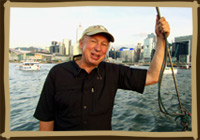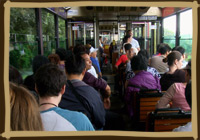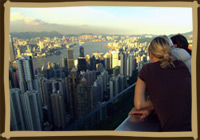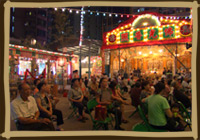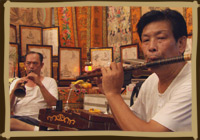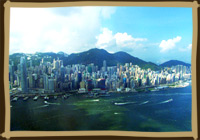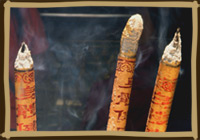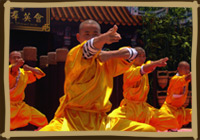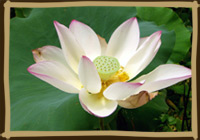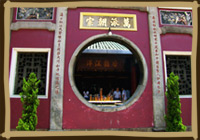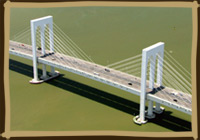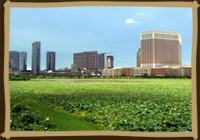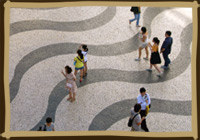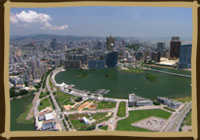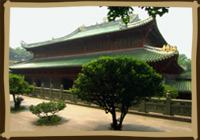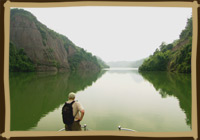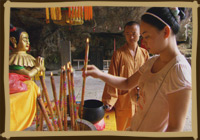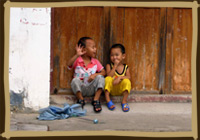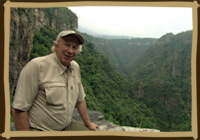
Richard On-Camera: Whether or not we name it, we all seek a balance among the moving parts of our lives. We strive for an agreement between our physical and spiritual worlds. Yet, too often we find ourselves incapable of summoning this state of being. Why?
Richard Voice-Over: There is a place whose people have been on a never-ending quest to achieve a concord between life's jagged puzzle pieces. And some believe they have found its secrets.
R VO: Harmony implies balance and the ability to integrate different elements into a pleasing unity. It incorporates the Chinese concept of yin/yang--opposite forces that come together to form a whole.
R OC: Chinese philosophers have long honored the concept of harmony. Confucius spoke of "harmony without uniformity," teaching that the world is full of contradictions, but that we should try to accommodate them to achieve a vital equilibrium.
R VO: Taoists believe that by following practices that achieve balance in daily life, they gain harmony with the universe. And the Buddha said that for the enlightened one, harmony is his joy, his delight, and his love.
R OC: Today, we see this fundamental value represented in so many different ways. In the trilogy of spaces we'll visit, we'll explore how the people of the Pearl River Delta seek harmony in this age.
R VO: In Hong Kong, we'll discover how the rounded shoulders of tradition find poise and meaning with the new and modern. In Macau, we'll explore how western sensibilities integrate with eastern aesthetics. And in Guangdong, we'll look at how some today are rediscovering ancient attitudes about integrating human workings with the natural world.
These destinations are all inextricably linked as star players on China's historic trade routes. Our quest begins in cosmopolitan Hong Kong, Asia’s world city, scoring the eastern edge of the Pearl River Delta.
R OC: At its most authentic, Hong Kong projects a vibrant duality, an ambition of opposites that work together in concert, which are the special ingredients of harmony.
R VO: Here, views of steel and glass pointing to the future rest against low stone temples coiling with the incense of deeply rooted traditions. The peak tram, which trundles to the top of the highest point on Hong Kong Island, is an emblem of the city's blending of beauty and practicality, vision and deed. In the days before air conditioning, wealthy residents discovered they could find relief from the city heat on top of Victoria peak. But the only way to ascend to these heights was by sedan chair. In 1881, an enterprising Scotsman introduced a new tram system that would ferry riders up the hill, and today it's a symbol of Hong Kong's ongoing desire to reach beyond the clouds.
R OC: Hong Kong's fortunes are due in no small part to the deep, protected waters of this harbor. And no ancient ship surpassed in size and technological prowess the Chinese "junk." for nearly two millennia, these ships harnessed the power of the wind to sail as far away as Japan and India.
R VO: The builders of these sturdy ships pioneered innovations in boat design that were modeled around the world. This hand-crafted junk, the "Aqua Luna," sails like a phantom of its namesake, a turn-of-the-century pirate who terrorized the South China Sea.
Today, Hong Kong has emerged as one of the world's busiest ports and also earned its standing as Asia’s cruise hub with a school of luxury ships purling in and about its harbor. Mixing water craft of all shapes and sizes, the scene stirs a peculiar pot of harmony: the triumph of kinetic energy over chaos.
Each day, tens of thousands of passengers ride the moving steps of the “Central to Mid-Levels escalator,” the longest outdoor covered people-mover in the world. This marvel of mobility provides a natural entry point for the many outstanding restaurants and shops as it passes through the trendy Soho area. Gliding effortlessly upward, visitors can behold an ever-changing pageant of entertainment options: hip bars and clubs, vibrant cafes, and sophisticated galleries.
Modern escalators can be a boon for tired feet, but thumbing back through time we see the Chinese attending to lower extremities centuries ago. Foot reflexology is the therapeutic practice of applying pressure to specific points on the feet.
R OC: The idea here is that there are pressure points in the foot that correspond to other parts of the body.
R VO: Massaging the appropriate points can help relieve ailments. In Chinese medicine as well as the Taoist religious tradition, Qi is the "life force" or energy that flows through all of us. If the Qi is blocked, a person can become ill. Practitioners believe that reflexology removes those blocks.
In a residential neighborhood on the city fringes, we discover another ancient tradition that pursues harmony--this time between the living and the dead. It's the annual hungry ghost festival, and in Hong Kong it's a major event. Hungry ghosts are the restless spirits of people who did not have descendants to provide a funeral. They never received the gifts the Chinese commonly offer up to their ancestors to pay respect. According to believers, once a year the gates of hell open and the ghosts are allowed to roam the earth. To persuade the restless spirits from creating problems for the living, many neighborhoods hold festivals in which they gather food and burn offerings to appease the visitors from beyond. Locals pray, asking the ghosts not to cause disturbances and to bestow peace, harmony, and happy living.
R OC: No question the streets here are energizing. But instinctively we know for our own well-being, we have to both engage and withdraw.
R VO: And when the energy of downtown reaches a pitch, we can retreat to the quiet and solitude of Hong Kong's outlying islands.
Here on Lamma Island, the lines of tension soften as we venture away from high-rises to pristine coastlines and outer island serenity. Lamma in Chinese means "the southern tree branch," and it reaches like the limbs of a sapling into a mural of blue waves. In a string of shore-side restaurants, the fruits of the sea and delighted diners are not strangers.
There is a Chinese concept known as "Double Happiness" that celebrates the symmetry and balance of love. And here, where no cars are allowed, the simple act of riding on two pedals or walking on two feet seems to bring double the relaxation, twice the joy.
Still relaxed from the island's influence, we ease back into the energy of Hong Kong via the gentle art of calligraphy. Throughout the dynasties, and still today, calligraphy was considered the purest art form. Calligraphy, as explained by scholars, is "the art of giving form to signs in an expressive, harmonious, and skillful manner." The calligrapher attempts to drive Qi, or the "life force," through a brush to spread the ink.
Chui Tze-Hung: Calligraphy is something for release. So, when you hold your brush and write, forget the troubles outside and concentrate. And try to be really in at that moment to do it.
R VO: Throughout the city, the ancient yearning to drive Qi through a brush takes a bend to the current in the city's contemporary art scene. Hong Kong is the world's third-largest art auction market.
Chang Tsong-zung: This is a Chinese-American artist, actually. It is a summer garden. And then--it's called a pagoda, but it's like a pagoda turning into... a human being. Yes, that's right. Transformer. Pagoda transformer.
R VO: Traditionally, Chinese art focused on rendering subjects as beautifully as possible, while contemporary art often leans toward challenging preconceptions and provoking the viewer.
CT: I think it's very important to exhibit art which comes from unorthodox tradition that has been brought up to date together with art which attempts to be rebellious, attempts to be completely critical. This is two sides of the same coin. And I think this link with the past is absolutely important. It allows us to see what our future is versus another person's future. And certainly for China, this visual link with a nature that is seductive, mysterious, transforms how one sees the contemporary city.
R VO: When it comes to food, Hong Kong's culinary offerings are like Chinese opera—rich, colorful, and hypnotic. Cantonese cuisine prizes freshness above all, and "wet markets" spill throughout the city, unruly, individual, swelling with slithering, flopping, gyrating flavors.
With thousands and thousands of eateries, I get the impression life in Hong Kong is merely the interlude between meals. The Four Seasons Hotel, home to two Michelin 3-star restaurants, is the rock star of the city's culinary scene.
William Mackay: Our philosophy has been to have two specialty restaurants that really exemplify the very best of what's available in those cuisines. Lung King Heen has star grouper, all the dim sum, xiao long bao, the barbecue dishes that are just fantastic. Caprice, on the other hand, is the very best of French food.
R VO: In keeping with the city's international leanings, Hong Kong's Caprice Restaurant delivers French cuisine in an open-kitchen setting.
Chef Vincent Thierry: When we make a plate, it's never to eat one part after the other one. You have to try to mix all together.
R VO: At the Lung King Heen restaurant, where Cantonese dishes take on a contemporary coil, the fresh, local ingredients are the highlight of every dish.
Denny Ip: The Cantonese cuisine are never spicy. Our freshness means that when you go to wet market, you go to the fish tank and if the fish is not swimming or moving, it's not fresh. Anything that moves, like the shrimp that jumps, that's fresh. That is freshness. And Cantonese cuisine are very bland. This to emphasize… I wouldn't say it's bland. It's very flavorful. It's just not spicy. Original taste of the food, that is what we are chasing after. It's the original taste of the food.
R VO: Some would call the towering hotels that slice through Hong Kong's skyline "temples to luxury." the Ritz Carlton, which bills itself as "the world's highest hotel," epitomizes the natural human longing to touch the stars. Here comfort knows no limits, and the deftly appointed rooms offer every amenity. This hotel furnishes more than 300 of the many tens of thousands of rooms available in Hong Kong—a necessity in a city that caters to over 36 million visitors a year.
Befitting its status as the wine hub of Asia, lovers of the grape can revel in the cache of the world's number-one wine auction market.
Roberto Garrone: As a point of view of collectors, Hong Kong is the place in the world where there is the most wine collected. Is a wine hub, is a wine and dining place. It is a place you only have to think about. You want something in Hong Kong? You can get it. And you wish to have a tailor-made suit? You can do that. You wish to have a beautiful product, and it's a very niche, very boutique product? You can get that. You want to find products that they are not available in some other markets? In Hong Kong, most probably you can find it. Being so near to China, being so near to all within two to three hours by plane, you can be within every place in Asia. It really gives you an opportunity to be really the hub of Asia in some way. And that's what really strikes for people to come to Hong Kong.
R VO: Seeking a temple of a different sort, I board the glass-bottomed cable car that flies over Lantau, the largest of Hong Kong's 200 islands. I'm revisiting one of my favorite sites: the Po Lin Monastery.
R OC: Here, amidst the plumes of incense, I can almost inhale the spirituality. Buddhism was introduced to China from India almost 2,000 years ago. And the Chinese then mingled traditional beliefs with Buddhist principles of peace and acceptance.
R VO: The Po Lin temple is a place of meditation, a chance to acknowledge limitations and seek enlightenment. Mysteries that perplex understanding seem to gather here: ideas about suffering and compassion, mindfulness and eternity.
Towering overall, the Giant Buddha sits in blaring quietude. To stand in his shadow is to surrender the din of life's chatter to moments of awe and silence.
On a small stage below the Buddha, the desire to find inner balance takes on physical form in a performance of shaolin kung fu. More than 15 centuries ago, monks in China laid the foundation for a martial arts system that sought to develop strong self-defense skills and promote health and longevity.
Leaving Hong Kong, we delve deeper into the roots of harmony as we cross the Pearl River Delta. Though a mere 40 miles from Hong Kong by ferry, Macau seems half a world away.
R OC: Some say it's difficult to be two things at once: playful and serious, homespun and refined, cosmopolitan and relaxed. Macau begs to differ.
R VO: Like Hong Kong, Macau is a special administrative region within China, giving it a high degree of autonomy, but its history takes a different twist. Long before Hong Kong was born, fishermen and farmers found this spot at the mouth of the Pearl River a strategic fix to set up shop. Try one of these. And while Hong Kong's trade history was bound up with England’s, Macau has links that stretch to southern Europe, with the intrepid explorers of Portugal.
For centuries, Macau was a stopping point for Silk Road merchants, who hauled goods from nearby Guangdong province onto ships bound for eager consumers in the west.
In the 16th century, Portuguese traders got the go-ahead from mandarins in Guangdong to take control of this delta gateway. Those westerners ferried shiploads of their culture here, much of which survive today.
Dr. Cora Wang: The maritime trade introduced by the Portuguese changed Macau gradually from a small fishing village to be the most significant international trade port in the territory of China. And that induced to have all kinds of intercultural exchange. For instance, we not just only celebrate Chinese festivals, for example like lunar New Year, we also celebrate catholic religious festivities, such as the colorful Easter procession is still celebrated in Macau today. So this is a very unique example that you can find in Asia, actually.
R VO: So, is there a symbol of Macau?
CW: I think Macau is known as the place of lotus, and the symbol mostly that we use actually is the lotus flower. And that symbolizes peace and harmony.
R VO: Senado Square, christened for the old senate building, served as the governing center for Portuguese officials and Chinese mandarins. The surrounding streets were the nexus between east and west, where cobbled mosaics met bamboo, evoking sweet-and-sour mixtures of foods, art, and architecture.
Is this Portuguese or Chinese? Chinese.
As if pulled by an invisible force, I’m drawn along the tiled main street of the city's historic center to the ruins of St. Paul's church. The Jesuits built this holy place in the 16th century, and it would become the most important Catholic Church in Asia. The building burned in 1835, leaving only these skeletal remains.
Above the church, heavy artillery peers out from the Mount Fortress. The early Jesuits constructed this fort as a stronghold against challengers. When Dutch ships invaded the island, a fleeing priest fired into the Dutch gunpowder vessel, blowing it and half the fleet into the sky.
Other parts of the historic center reflect the duality and integration of the unique ethos that evolved here.
R OC: Mediterranean sensibilities blended effortlessly with local Chinese culture, dignifying a harmony that became not only agreeable, but irresistible.
R VO: Right next to the Christian St. Paul's is the ancient Na Tcha Temple, used for both Buddhist and Taoist worship. Here at St. Dominic's Church, the first Portuguese newspaper in China was published. And the Holy House of Mercy has served as a place of charity and piety for both Europeans and Chinese.
A few miles from the historic center, the A-Ma Temple is one of the city's oldest shrines and it draws worshippers from all the major Chinese religions.
Dr. Chin-Ee Ong: Within Chinese religions, there is a very, very big tolerance of faiths and deities, for instance. Because although this is technically the A-Ma Temple, or temple that is devoted to the mazu, or the goddess of the sea, we see on the top of the hill Kun Iam Hall, a hall that is actually dedicated to another--well, in Buddhism she would be considered as a Bodhisattva, the Guanyin. So you see a mixing of faiths as well.
R OC: Like so much of the architecture here, this temple has a duality of purpose: it's both a beacon to sailors and a warning to evil spirits.
R VO: The temple honors A-Ma, the seafarers' goddess, and is the inspiration for the name Macau.
Legend tells that a poor girl was seeking passage to the upper Pearl River Delta, but none of the wealthy boatmen would help her. When a lowly fisherman finally offered her a ride, a huge storm swept in, sinking all the boats except the one holding the girl. When she landed in Macau, she vanished, only to reappear here, in the form of the goddess A-Ma.
The nearby Moorish Barracks are still stately after more than 130 years. This was home to a regiment of Indian soldiers that the Portuguese authorities brought in to bolster local police and help maintain order. 200 men made their home in these quarters.
The Mandarin's House, an upper-class compound, unfolds over some 13,000 square feet, the largest private residence in Macau. Home to an important 19th-century Chinese writer and reformer, the buildings show subtle influences from abroad, the genesis of an era when Chinese building design began to display a fusion of styles from opposing continents.
OC: With the insight of history, we can distinguish the strands that came together to form this city, yet who could have predicted the weavings, the rich tapestry of its fortunes today?
R VO: A drive across the Macau-Taipa Bridge transports us to the islands of Taipa and Coloane, cradling concrete and crystal that herald the future, as well as hand-hewn villages that summon the past.
On Taipa, five tidy green and white houses sit in a row, tributes to Macau's early success. Built almost a century ago, these were the homes of well-to-do Macau families and high-level government workers. Here is a view of the cadence of everyday life: the simple routines of families, work schedules built around the shrimp paste and fireworks industries, and indoor life among stylish furnishings that incorporated western sensibilities and eastern finesse.
The drowsy village of Coloane, once a haven for pirates, echoes with reminders of its maritime legacy. On the waterfront, rows of dried fish hang in anticipation of passing shoppers. The baroque church of St. Francis Xavier still waits patiently for its missionary namesake, who died of fever on his way here. And visitors prowl the cobbled lanes in search of a mid-morning snack.
R OC: Could I have two boxes of egg tarts?
R VO: An appetizing mixture of East and West--that's the Portuguese egg tarts in Lord Stow's Bakery. Lord Stow, a Brit living in Macau, was not a lord, but his clients called him that for the noble tarts he invented, an original variation of those served in dim sum restaurants and European bakeries. His version is, I must say, even more decadent than those, with its wickedly rich custard filling in buttery pastry shells. First concocted in 1989, Lord Stow's Bakeries now sell about 3,000 egg tarts a day.
R OC: The people of Macau have always looked beyond for their livelihood: first to the sea, and today to visitors who flock here for the resorts, the shows, the eateries, and the history.
R VO: Like its inspiration, Las Vegas, the Cotai strip is a dazzling parade of casinos and high-end hotels. We're exploring this 3-mile stretch, built on reclaimed land between Taipa and Coloane: a mirage wavering into a true modern oasis.
A simulation celebration of the splendor of Old Europe, the Venetian Macau is big enough to hold 90 Boeing 747s. With 3,000 rooms, more than 30 restaurants, and a million square feet of shops, this is where easterners and westerners alike come to wine and dine, stay, and play. Running through the heart of the hotel is a re-creation of Venice’s Grand Canal, where gondoliers serenade passengers past the Italianate facades.
[Gondolier Aurelia Lamonde singing in Italian]
R VO: Large-scale replicas of famed Venice landmarks, such as the Doge's Palace and St. Mark's Square, float seductively by. It is the old riff come true: if you want to see how beautiful my baby, you have to see her picture.
R OC: A place like this arouses admiration. But perhaps more noteworthy, it inspires us to open our wallets and sail with lady luck.
R VO: Another berth where cross-cultural notions of luxury find synergy is the nearby Galaxy Macau Hotel with its Banyan Tree Villa. The villa takes its name from the stout but graceful fig tree under which the Buddha achieved enlightenment. Is it possible to find inner harmony in a resort? Perhaps not, but it does seem a tempting, if transitory, escape from matters of the mortal world.
The City of Dreams is something different. This planetary-sized property offers a galaxy of gambling venues and endless star-clustered entertainment. At some point, we all want to be someone we're not. And in the Hard Rock, I’m swept into the electric world of a rock star. And most of us also enjoy the agreeable kind of terror served up in scary movies, such as found here in the world's largest projection dome, where plays the fiery immersive experience, the Dragon Treasure show.
R VO: Food, like everything else in Macau, has a singularity and zest all its own. In Antonio’s small homey dining room, locals linger over Portuguese versions of sausage, lobster, and fish. Renowned chef Antonio serves up his meticulously prepared dishes, such as sizzling crepes and spicy African chicken, with flame and flair. Portuguese cuisine is heavily influenced by its seafaring past, and the dishes here creatively pull in ingredients and seasonings from the far-flung ports of the world.
Echoes of Europe are found throughout the city's eateries. Lovers of modern Italian cuisine head to the Michelin-starred Aurora Restaurant in the trendy Altira Hotel. Here, fruits of the field, garden, and sea find a special kind of synergy under the delicate touch of Chef Michele.
Chef Michele dell’Aquila: The most important is create the experience. The people has to be amazing from the dish, from the tasting, from the flavor, because you cannot find these ingredients any place in Macau, any part. And also in the restaurant, is nobody using this carruba—yes, because it's different. This is an ingredient what my grandmother was using long time ago. Now it's a kind of a past ingredient combined with a new generation, new things. It's always work well.
R VO: Grounded in the techniques of his Italian legacy, the chef transforms an array of contemporary combinations, such as organic salads and seafood-inspired pastas--a treat for both the palate and the eyes.
[Here we go. 5, 4, 3, 2, 1! All right. Get going.]
R OC: Wow, look at this! The Pearl River Delta, Macau, Mainland China. This is a searing kind of harmony.
R VO: 'Scuse me while I kiss the sky. The 1000-foot high Macau Tower, built on reclaimed land on the southern tip of the Macau peninsula, opens up panoramas of the urban and natural worlds draped together. Attached to straps, I can walk like an aerialist around the outer rim.
This is an inspiring spot to say good-bye to Macau as we dive into the next leg of our journey.
Spread along the southernmost tip of the mainland and rimmed by more than 2,000 miles of coastline, Guangdong Province has long served as the threshold to northern China and its window to the outside world.
As a vital stretch of the ancient Silk Road, this was once a prime path for foreign merchants venturing to trade with China. Just as in centuries past, when goods flowed through this province feeding the port cities of Macau and Hong Kong, Guangdong’s role as a nerve center of commerce continues today. Deemed the most prosperous and dynamic face of China, this is the hub of modern industry and the kingpin of tourism. The capital city of Guangzhou, once known to westerners as "Canton," is the third-largest city in China and reigns over Pearl River commerce. Pulsing with cultural diversity, this makes a great springboard to compelling historic sites, World Heritage wonders, and some of the most beautiful natural scenery in China.
R VO: A few hours north of Guangzhou, near the city of Shaoguan, lie the nuanced curves of Nan Hua Temple and the arresting landscapes of Danxia Mountain Park.
Nan Hua Temple was built in honor of a monk named Hui Neng, the founder of the southern sect of Zen Buddhism in China and a revered figure in Chinese history. As a poor, illiterate peasant boy, Hui Neng achieved enlightenment when he heard a man reciting a line from Hindu scripture. The line he heard was, "depending upon nothing, you must find your own mind."
Chinese Buddhist temples are different from those in India, Japan or other Buddhist countries. They're generally modeled after the Chinese imperial palaces, with a front hall, great hall, and back hall, each holding different representations of the Buddha, and all integrated with one another and with the natural surroundings.
R VO: The belly of the earth has bulged, wrenched, and kinked in Danxia Mountain Park. There are spirits clad in emerald forest and red stone. Part of a UNESCO world heritage site, the nearly 70,000 acres of this park are nature's great sculpture garden. The United Nations honored this spectacularly rugged landscape with World Heritage status in 2010.
The Jinjiang River helixes through the Danxia Mountains for just over 20 miles. Framed by rose-colored walls, it winds its way past a procession of gardens, vegetable fields, and bamboo groves. The natural formations, when viewed through human eyes, have taken on a deeper, sometimes mystical, sometimes whimsical significance. We drift by scenes dubbed such as: "A Group of Elephants Coming Out of Mountain," and "Gold Tortoise on a Pilgrimage." These images can't help but make you smile.
R OC: Now, this would be a beautiful place to create apartment buildings and factories and businesses. Why do you want to preserve this?
Translator for Liu Yu Cheng: I’m a city boy, born in the city. I don't know about other people, but to me, coming back to Mother Nature is where I always want to be. I've seen enough of the buildings, and coming back here, I find my place. This is the place where I find my harmony.
R VO: Elder Peak is one of three rock shapes that form the crown of Danxia Mountain. This otherworldly landscape, looking more like the contours of the moon than an earthbound park, has been an inspiration to poets and essayists past and present, some compelled to leave evocative etchings in the ramparts of red rock.
The undulating mountains and a network of trails call to hikers with the promise of easy discovery and wonderment.
R VO: Do you have a favorite place in this park?
Translator for Hou Rongfeng: My favorite spot is the rock behind you. Every time I come up here, I feel harmonious. I strongly believe that humans have too much greed and ambition, and they are chasing too many things. At the end of the day, they just create more and more troubles and questions. I always say that if anyone would come here and look at this big cliff of rock, you will find that you are so small, and then hopefully you won't be thinking so sideways.
R VO: Danxia Mountain is actually one of six similar land areas that make up what the world heritage list refers to as "Danxia China." these rugged landscapes, enveloped by a warm, humid climate, help conserve great stretches of sub-tropical forest. Evergreen sanctuaries, they offer protection for more than 400 rare or threatened plant and animal species.
This park also provides sanctuary of another sort, in the form of small grotto temples carved in the mountain walls.
A scattering of sites fan out around Shaoguan, virtually unknown to westerners, but deeply rewarding to those who seek them out. There's historic Zhuji Lane to the northeast, the Ancient Buddha Rock to the northwest, and the mountain village of Bibei Yao Fastness.
R VO: A thousand years ago, ancient Zhuji Lane became prosperous due to its prime location on a trading route between China's central plains and the south. No footstep ever fell in the wrong place here. The cobblestone road is lined with ancestral halls, relic homes, and ancient temples. According to folklore, the Zhang Chang family lived together here for 7 generations, and received a special award from the tang emperor for showing such great respect for family. Huge numbers of Chinese who emigrated overseas came from southern China. And because so many of their descendants trace their roots to Zhuji lane, it's become known as the "hometown of the Cantonese."
The marvels of the physical and spiritual worlds merge in the Ancient Buddha Rock and in the cave system that sprawls below. There's something about caves that rouses the imagination, inspiring childlike anticipation in all who enter. It's as if they're portals to adventure: prehistoric and otherworldly. I was a passionate caver when young, probing the limestone recesses of America’s Eastern Seaboard, but I am unprepared for the depth of awe this enormous grotto evokes. It was formed over hundreds of millions of years, expanding into a series of linking rooms and corridors that stretch for 13,000 square feet. While above the summer heat swelters near 100 degrees Fahrenheit, here the year-round temperature hangs at a comfortable 67 degrees. Limestone caves are formed by natural acid in rain that seeps through the ground. The acidic water reacts chemically with limestone bedrock, gradually resulting in this wonderwork of flowing stone: nature's own house of quiet veneration.
Many seeking enlightenment through compassion travel to the Buddhist temple carved in the cavern rim. It's dedicated to Guanyin or the "Goddess of Mercy."
R OC: The goddess' name translates to: "Observing the Cries of the World." Her followers believe she quells suffering and brings harmony and peace to all in her gaze.
R VO: Some Buddhists believe that when they die, Guanyin places them in the heart of a lotus flower and sends them off to the "Land of Bliss."
Surrounded by high, steep nearly inaccessible cliffs, the town of Bibei Yao Fastness is a cultural awakening. [Woman singing] This is the historic home of the Yao, a mountain-dwelling people native to China's south. With a welcoming cup of tea, the villagers beckon me in. [People speaking native language] I walk among dwellings built in their typical raised-rectangle style as though I’m wandering through a doorway to the past.
The Yao trace their history back more than 2,000 years. Expert weavers and embroiderers, they're proud of their exquisitely brocaded fabrics. Many preserve their ancestral costumes as a way of maintaining their identity. The women of this village still practice a traditional form of needlework, distinct in China, because of stitching on the backs of garments.
There are more than 2.5 million Yaos living in villages across China's southern mountains. They have such unique lifestyles that traditions vary from one community to the next. Here, the ritual of climbing up a ladder made of swords is practiced as a way of asking dead spirits to rest in peace.
Before the 1950s, few Yao children had formal schooling, but today nearly all receive elementary and secondary educations. Yet despite their exposure to the outside world, these young people continue to nurture their culture's magnificent oral literary tradition. [Chanting in native language] Rich in content, Yao folk songs range from beautiful love stories to historic anecdotes, from questions about heaven and earth to tales of humor and fun. The songs pass down to each successive generation.
Sheer sandstone walls claw to the clouds from Guangdong’s Grand Canyon. At nearly 1,000 feet deep and 9 miles long, this is for me a gaping call to adventure. The canyon's diadem of glory is the Chengtou Waterfall, which fonts from a high ravine like an unleashed dragon.
R OC: This place means a lot to me. For seven seasons, I was a guide in America’s Grand Canyon, and now any place that shares that name calls mine. It's a gift to be able to share a friendship between belief and place, a soothing of the tensions between the curves and straight lines of our lives.
R VO: More than 1,300 stone steps, educated out of the savagery of the craggy cliffs, form a stairway for those willing to test their mortal might and descend into the dark canyon depths. How can I resist? This seems a natural place to reflect on life's grand questions, as Taoists do, through inner meditation and outer observation.
"Above all, prize harmony," taught Confucius. And Hong Kong, Macau, and Guangdong offer tantalizing clues to the wisdom of the ancients and sign posts away from confusion. Whether it's the aesthetic beauty reflected in art, the simple rhythms of daily life, or the equilibrium found in nature...it's the ability to find balance that makes life complete.
R OC: Whether consciously or not, we all long for a harmony that quietly returns us to ourselves.
R VO: What you can do:
- Participate in Chinese festivals in your own area.
- Study the teachings of Chinese scholars such as Lao Tzu and Confucius.
- Learn more about the concept of Qi.
- Visit the Pearl River Delta and see for yourself.
R VO: For more information and links visit our web site: AdventuresWithPurpose.tv.
